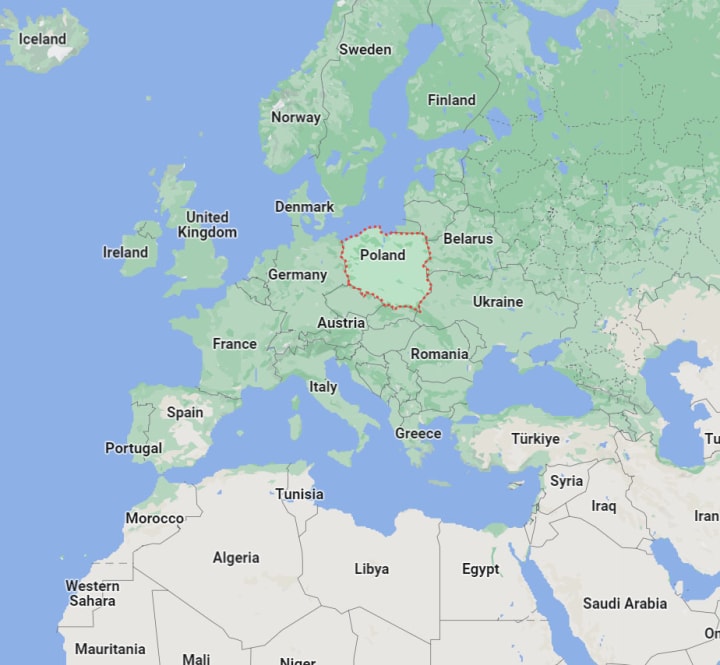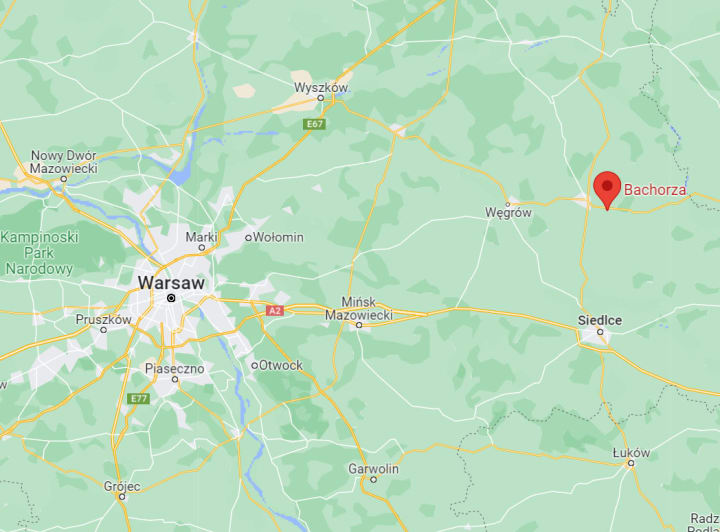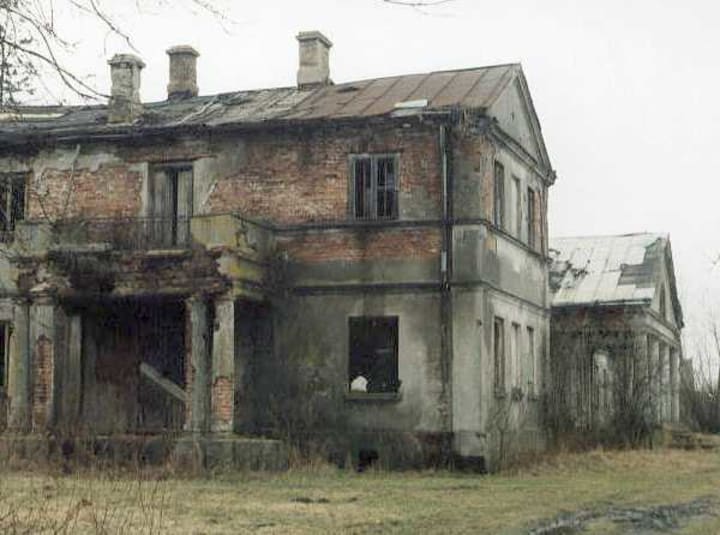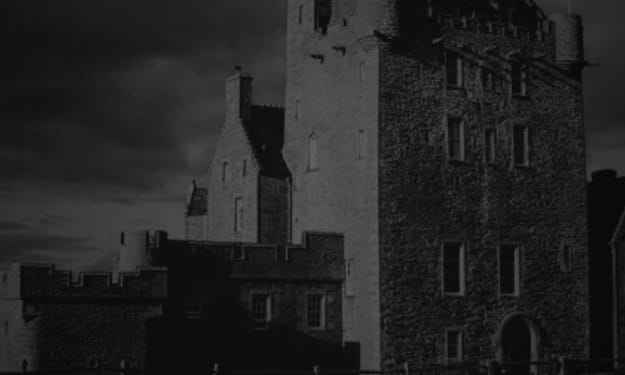Restless Spirits of Bachorza Manor in Poland
An old, crumbling manor house in Poland with a restless spirit.

Deep within Poland's beautiful landscape stands a place called Bachorza Manor. Bachorza Manor has long been a topic of interest for people who are into architecture and ghostlore. It has a fascinating past, full of grandeur, tales of aristocracy, and, somewhat more recently, whispers of apparitions and dark shadows. Let's briefly tour Poland to find our way to Bachorza Manor, where the boundaries between history and legend blur.
Where is Bachorza?
If you don't know where Poland is, here's a map:

Poland is home to all sorts of interesting and unusual places, like the Crooked Forest. It's near the town of Gryfino in western Poland. Over 400 pine trees grow in the Crooked Forest, each with a 90-degree bend at their base, making them look like a forest full of J's. It seems like something right out of a children's story or some kind of fairy tale.
And, as far as unusual places go, Poland also has the world's largest castle: Malbork Castle. It's absolutely massive, clocking in at 143,591 square meters (1,545,601 square feet). That's about 35.5 acres. For comparison, the average size of Costco in the United States is only a mere 146,000 square feet.
The entire country is full of legends, like one that says a Nazi train filled with gold and other treasures was buried underground near Wrocław during the final days of World War II. Efforts to find the so-called "Gold Train" have been made, but its existence remains unconfirmed.
In east-central Poland lies Mazovia Province (Masovian Voivodeship), where the country's capital city of Warsaw is located.

In Warsaw, there's a place called Wilanów Palace. It's a beautiful example of Baroque architecture, and it just so happens to hold one of the oldest collections of Polish portraits—some of which have eyes that seem to follow visitors as they move about.
About an hour and a half drive east of Warsaw is a village called Bachorza. And, unless you speak Polish, you probably have no clue how to say the word "Bachorza." You're in luck because I found these two recordings: Bachórz and Dwór w Bachorzy.

Bachorza, like many smaller locales within Poland, has been a hub of Polish culture and history for centuries. The entire Masovian Voivodeship itself has been at the crossroads of quite a few well-known events from European history, including two World Wars.
Nestled in the small village of Bachorza is a 19th-century classicistic manor house: Bachorza Manor. It's a remnant of Poland's szlachta (nobility) culture and represents the lifestyle, architecture, and tastes of the Polish aristocracy of that era.
I know what you're thinking. Bachorza Manor sounds like a charming house in the picturesque countryside, an aristocrat's architectural marvel that would be an absolute dream to visit. A vacation destination where you could land in Warsaw, take a scenic drive to Bachorza village, and then perhaps a lovely carriage ride over to Bachorza Manor, where you would stay for a few nights in one of the rooms for a delightful bed and breakfast experience.
Well...

If you do that, please report back if you make it out alive.
History of Bachorza Manor
The Sokołów estates, which includes Bachorza Manor, had numerous owners over the centuries, from the Radziwiłłs and Krasińskis to more recent figures like Teofil Zaleski.
The manor's oldest section dates back to the late 18th century when it was owned by Michał Kleofas Ogiński, author of the polonaise Pożegnanie Ojczyzny.
I know you're dying to know more about "polonaise," but I had trouble finding anything in English. It is a word to describe a slow dance of Polish origin, and Pożegnanie Ojczyzny is a piece of music for that type of dance.
Ownership of Bachorza Manor changed hands multiple times in the subsequent centuries, with significant renovations occurring under Antoni Odrowąż-Wysocki, who used it as a hunting lodge. In the 1930s, after Wysocki's untimely death (probably hunting related...), a nobleman and landowner named Teofil Dołęga-Zaleski became the owner. Dołęga-Zaleski owned Bachorza Manor until about 1945 when the Soviet Union's Red Army took it and proceeded to abuse the hell out of it.
Bachorza Manor fell into ruin.

Oddly, the name "Bachorz" traces back to its own intriguing tale: a baby was found on the manor's steps during a winter night. The heiress of the manor took an interest in the child, who eventually grew up on the estate and was later appointed as its manager. Locals, however, disparagingly referred to the estate as the place of a "bundle-brat" due to this event.
That's quite the history, and I only gave you some highlights.
Ghosts of Bachorza Manor
Whispers of local ghostlore surround the ruins of Bachorza Manor, claiming the manor is both cursed and haunted. Stories tell that unsettling events began unfolding at the estate just before the beginning of World War II.
Night-time brought inexplicable sounds, and artwork detached itself from walls. The manor's mistress was plagued by recurring nightmares, and objects within the manor would vanish and reappear mysteriously—often in places other than where they disappeared. The occupants, owners, and servants of Bachorza Manor all reported odd sounds coming from empty rooms. Teofil Dołęga-Zaleski's wife, Natalia, claimed to have seen a parade of full-body apparitions dressed in old-fashioned clothing.
War-time tragedies further deepened the manor's sad legacy. After the manor's mistress fell gravely ill, one of the Zaleski daughters passed away, soon followed by Natalia.
In 1943, two of Zaleski's daughters, both members of the Home Army, were captured and sent to the Nazi's Treblinka extermination camp. There, Anna met a cruel fate and was executed. In another sorrowful twist, Henryk Oleksiak, the spouse of Zaleski's fourth daughter and a Podlaskie Home Army unit leader, lost his life during a covert operation. The dark days didn't end there; Janina, another Zaleski daughter, found herself in the grasp of the NKVD and was subsequently banished to Siberia.
NKVD
Federal agency
The People's Commissariat for Internal Affairs, abbreviated NKVD, was the interior ministry of the Soviet Union. Established in 1917 as NKVD of the Russian Soviet Federative Socialist Republic, the agency was originally tasked with conducting regular police work and overseeing the country's prisons and labor camps. Thanks, Wikipedia.
Fair warning: if you dive into a hole to learn more about the NKVD, prepare yourself for the truly horrific.
These tales, both supernatural and tragically real, make the Bachorza Manor a poignant reminder of a past that must never be forgotten, blurring the line between history and legend.
Relevant & Related
- Read more about Bachorza Manor from someone very much connected to the house's history. The site is in Polish, but I've linked to an English translation: mansions, palaces...Sentimental and Nostalgic Journey II. The page is full of old photos, so you can see Bachorza Manor in various states over the centuries.
- Check out more about the Crooked Forest in Poland. You also wouldn't believe how hard it is becoming these days to find videos on YouTube that aren't questionably copyrighted images or videos paired with dumb robotic voices doing text-to-speech straight off Wikipedia. Oh, and stock YouTube music with the volume way too high. /rant-off
- And don't miss a walking tour of the absolutely massive Malbork Castle in Poland.
- Learn more about the legend of the Nazi gold train, and watch a bit about the efforts to locate it. A non-fiction book was written about this and other real-life stories of Nazis hoarding and stashing art and other valuables. Check out The Monuments Men: Allied Heroes, Nazi Thieves, and the Greatest Treasure Hunt in History by Robert M. Edsel. There was also a film adaptation of the non-fiction book titled The Monuments Men.
- Find out more about Wilanów Palace at its official website.
- Want to learn more about the NKVD? Try The NKVD: from Pen-Pushers to Communist Hit Squads.
- Check out more articles I've written about things near Bachorza: Zdzisław Beksiński | Ghosts of Ogrodzieniec Castle in Poland | Ghosts of Omenainen Island | Krampus of Alpine Folklore | The True Story of Arnold Paole, Vampire of Meduegna, Serbia | Jure Grando of Kringa, Croatia
~
Originally published in my weekly newsletter, Into Horror History - every week, I explore the history and lore of horror, from influential creators to obscure events. Cryptids, ghosts, folklore, books, music, movies, strange phenomena, urban legends, psychology, and creepy mysteries.
About the Creator
J.A. Hernandez
J.A. Hernandez enjoys horror, playing with cats, and hiding indoors away from the sun. Also, books. So many books—you wouldn't believe.
He runs a weekly newsletter called Into Horror History and writes fiction.
https://www.jahernandez.com






Comments
There are no comments for this story
Be the first to respond and start the conversation.